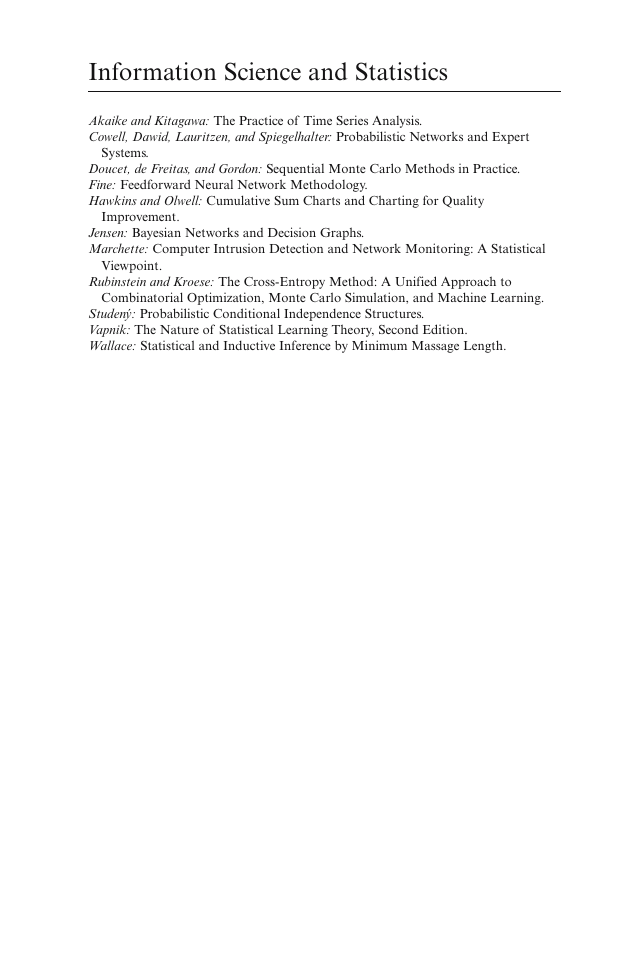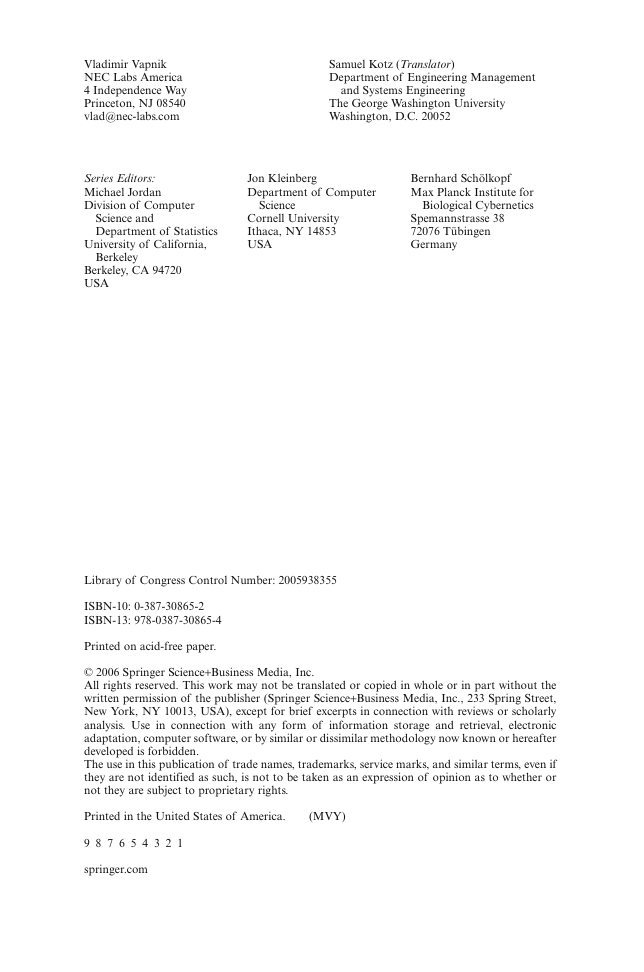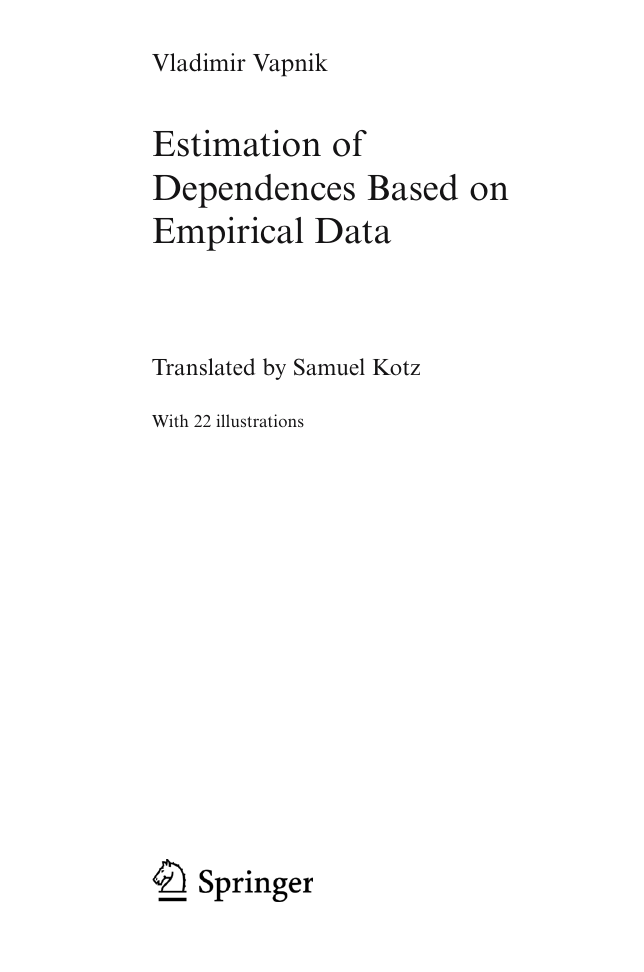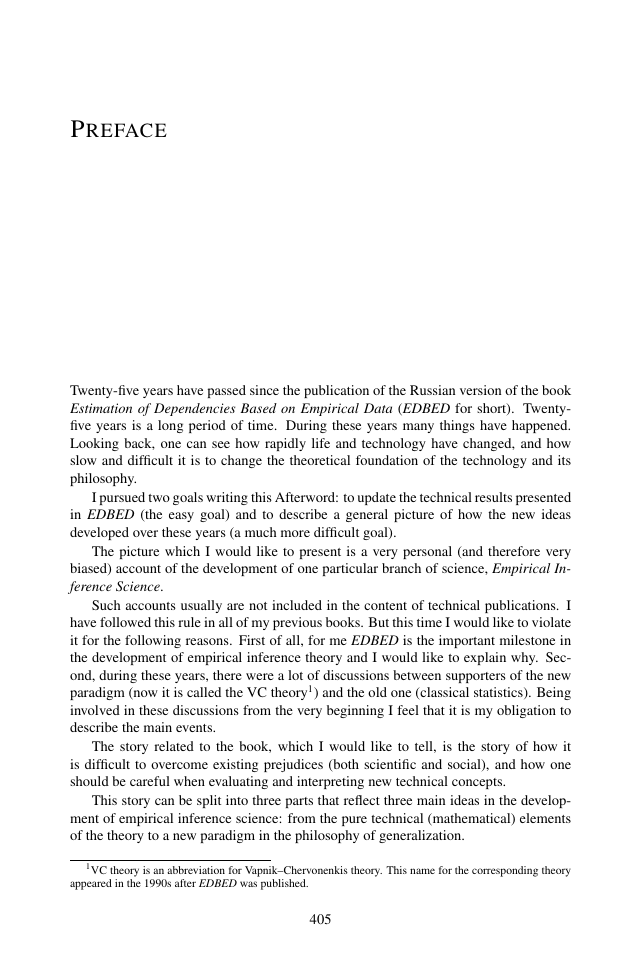�
Information Science and Statistics
Series Editors:
M. Jordan
J. Kleinberg
B. Schölkopf
Information Science and Statistics
Akaike and Kitagawa: The Practice of Time Series Analysis.
Cowell, Dawid, Lauritzen, and Spiegelhalter: Probabilistic Networks and Expert
Systems.
Doucet, de Freitas, and Gordon: Sequential Monte Carlo Methods in Practice.
Fine: Feedforward Neural Network Methodology.
Hawkins and Olwell: Cumulative Sum Charts and Charting for Quality
Improvement.
Jensen: Bayesian Networks and Decision Graphs.
Marchette: Computer Intrusion Detection and Network Monitoring: A Statistical
Viewpoint.
Rubinstein and Kroese: The Cross-Entropy Method: A Unified Approach to
Combinatorial Optimization, Monte Carlo Simulation, and Machine Learning.
Studen´y: Probabilistic Conditional Independence Structures.
Vapnik: The Nature of Statistical Learning Theory, Second Edition.
Wallace: Statistical and Inductive Inference by Minimum Massage Length.
�
Vladimir Vapnik
Estimation of
Dependences Based on
Empirical Data
Reprint of 1982 Edition
Empirical
Inference Science
Afterword of 2006
�
Vladimir Vapnik
NEC Labs America
4 Independence Way
Princeton, NJ 08540
vlad@nec-labs.com
Samuel Kotz (Translator)
Department of Engineering Management
and Systems Engineering
The George Washington University
Washington, D.C. 20052
Series Editors:
Michael Jordan
Division of Computer
Science and
Department of Statistics
University of California,
Berkeley
Berkeley, CA 94720
USA
Jon Kleinberg
Department of Computer
Science
Cornell University
Ithaca, NY 14853
USA
Bernhard Schölkopf
Max Planck Institute for
Biological Cybernetics
Spemannstrasse 38
72076 Tübingen
Germany
Library of Congress Control Number: 2005938355
ISBN-10: 0-387-30865-2
ISBN-13: 978-0387-30865-4
Printed on acid-free paper.
© 2006 Springer Science+Business Media, Inc.
All rights reserved. This work may not be translated or copied in whole or in part without the
written permission of the publisher (Springer Science+Business Media, Inc., 233 Spring Street,
New York, NY 10013, USA), except for brief excerpts in connection with reviews or scholarly
analysis. Use in connection with any form of information storage and retrieval, electronic
adaptation, computer software, or by similar or dissimilar methodology now known or hereafter
developed is forbidden.
The use in this publication of trade names, trademarks, service marks, and similar terms, even if
they are not identified as such, is not to be taken as an expression of opinion as to whether or
not they are subject to proprietary rights.
Printed in the United States of America.
(MVY)
9 8 7 6 5 4 3 2 1
springer.com
�
Vladimir Vapnik
Estimation of
Dependences Based on
Empirical Data
Translated by Samuel Kotz
With 22 illustrations
�
To the students of my students in memory of my violin teacher
Ilia Shtein and PhD advisor Alexander Lerner, who taught me
several important things that are very difficult to learn from
books.
�
PREFACE
Twenty-five years have passed since the publication of the Russian version of the book
Estimation of Dependencies Based on Empirical Data (EDBED for short). Twenty-
five years is a long period of time. During these years many things have happened.
Looking back, one can see how rapidly life and technology have changed, and how
slow and difficult it is to change the theoretical foundation of the technology and its
philosophy.
I pursued two goals writing this Afterword: to update the technical results presented
in EDBED (the easy goal) and to describe a general picture of how the new ideas
developed over these years (a much more difficult goal).
The picture which I would like to present is a very personal (and therefore very
biased) account of the development of one particular branch of science, Empirical In-
ference Science.
Such accounts usually are not included in the content of technical publications. I
have followed this rule in all of my previous books. But this time I would like to violate
it for the following reasons. First of all, for me EDBED is the important milestone in
the development of empirical inference theory and I would like to explain why. Sec-
ond, during these years, there were a lot of discussions between supporters of the new
paradigm (now it is called the VC theory1) and the old one (classical statistics). Being
involved in these discussions from the very beginning I feel that it is my obligation to
describe the main events.
The story related to the book, which I would like to tell, is the story of how it
is difficult to overcome existing prejudices (both scientific and social), and how one
should be careful when evaluating and interpreting new technical concepts.
This story can be split into three parts that reflect three main ideas in the develop-
ment of empirical inference science: from the pure technical (mathematical) elements
of the theory to a new paradigm in the philosophy of generalization.
1VC theory is an abbreviation for Vapnik–Chervonenkis theory. This name for the corresponding theory
appeared in the 1990s after EDBED was published.
405
�
















 2023年江西萍乡中考道德与法治真题及答案.doc
2023年江西萍乡中考道德与法治真题及答案.doc 2012年重庆南川中考生物真题及答案.doc
2012年重庆南川中考生物真题及答案.doc 2013年江西师范大学地理学综合及文艺理论基础考研真题.doc
2013年江西师范大学地理学综合及文艺理论基础考研真题.doc 2020年四川甘孜小升初语文真题及答案I卷.doc
2020年四川甘孜小升初语文真题及答案I卷.doc 2020年注册岩土工程师专业基础考试真题及答案.doc
2020年注册岩土工程师专业基础考试真题及答案.doc 2023-2024学年福建省厦门市九年级上学期数学月考试题及答案.doc
2023-2024学年福建省厦门市九年级上学期数学月考试题及答案.doc 2021-2022学年辽宁省沈阳市大东区九年级上学期语文期末试题及答案.doc
2021-2022学年辽宁省沈阳市大东区九年级上学期语文期末试题及答案.doc 2022-2023学年北京东城区初三第一学期物理期末试卷及答案.doc
2022-2023学年北京东城区初三第一学期物理期末试卷及答案.doc 2018上半年江西教师资格初中地理学科知识与教学能力真题及答案.doc
2018上半年江西教师资格初中地理学科知识与教学能力真题及答案.doc 2012年河北国家公务员申论考试真题及答案-省级.doc
2012年河北国家公务员申论考试真题及答案-省级.doc 2020-2021学年江苏省扬州市江都区邵樊片九年级上学期数学第一次质量检测试题及答案.doc
2020-2021学年江苏省扬州市江都区邵樊片九年级上学期数学第一次质量检测试题及答案.doc 2022下半年黑龙江教师资格证中学综合素质真题及答案.doc
2022下半年黑龙江教师资格证中学综合素质真题及答案.doc